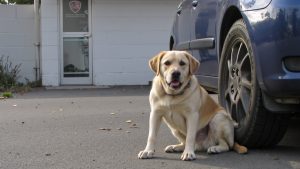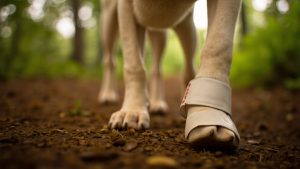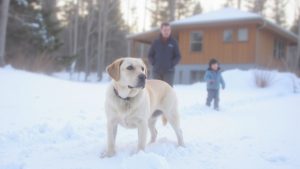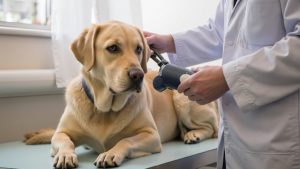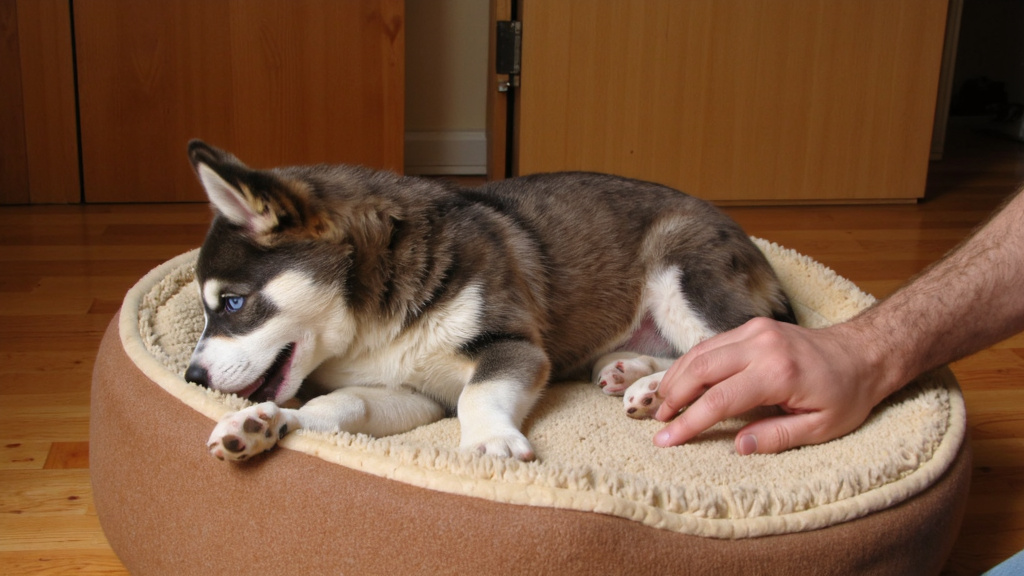
Every minute counts when a dog develops bloat. What appears as simple discomfort can escalate to a life-threatening emergency within hours—sometimes even faster. Gastric dilatation-volvulus (GDV), commonly known as bloat, stands as one of the most devastating conditions veterinarians encounter in emergency rooms nationwide.
When bloat occurs, the stomach fills with gas and fluid, expanding beyond its normal size. In severe cases, this distended stomach actually rotates on itself, cutting off blood supply to vital organs and trapping gas inside with no way to escape. This twisting action transforms a concerning situation into a critical emergency with mortality rates reaching 20-45% even with prompt treatment.
What Can Dog Owners Do to Prevent GDV in Dogs?
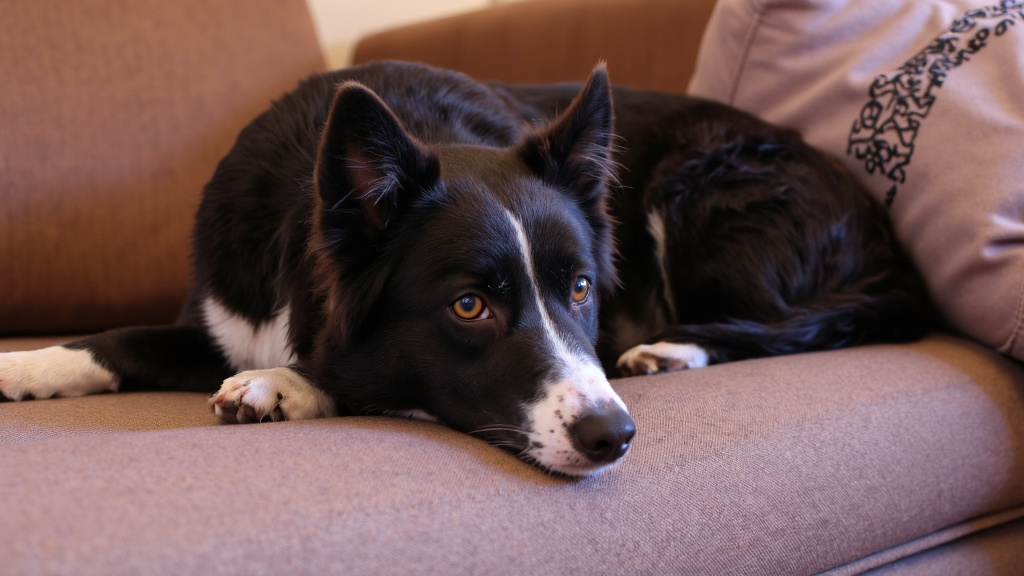
Canine bloat, or gastric dilatation-volvulus (GDV), strikes without warning and can kill within hours. Deep-chested breeds like Great Danes face a 42% lifetime risk, but no dog is immune. Preventative steps significantly reduce this potentially fatal condition.
Dr. Timothy Robinson, a board-certified veterinary surgeon, recommends: “All giant breeds and other at-risk breeds should have a preventive gastropexy performed. It is preferable to see healthy dogs in the operating room for this procedure than in critical condition during a GDV surgery.”
Essential Prevention Strategies
- Feed smaller, frequent meals – Divide food into 2-3 smaller portions throughout the day to prevent excessive stomach stretching.
- Manage eating speed – Dogs who eat quickly increase their risk by swallowing excess air. Puzzle feeders or slow-feeder bowls can turn mealtime from a quick gulp into a 10-minute engagement.
- Control water intake – Avoid allowing dogs to drink large quantities of water at once, especially after exercise.
- Time exercise carefully – Wait at least an hour after meals before vigorous play or exercise, and don’t feed immediately after intense activity.
- Avoid raised food bowls – Research from Purdue University shows elevated bowls may increase bloat risk in large breeds.
Preventative Surgery Options
For high-risk breeds like Great Danes, Saint Bernards, and Weimaraners, preventative gastropexy is worth discussing with a veterinarian. This procedure tacks the stomach to the abdominal wall during routine spay/neuter surgery, reducing future GDV risk from 76% to just 6%.
When Max, a 4-year-old German Shepherd with a family history of GDV, showed signs of food sensitivity, consultation with a vet about preventative options led to gastropexy during his dental cleaning. Slow feeding and smaller meals were implemented. Three years later, a minor bloat episode occurred, but the gastropexy prevented deadly stomach twisting.
Stress Management
Anxious dogs face higher bloat risk. Establish consistent routines and create calm eating environments. If a dog guards food or eats nervously around other pets, consider feeding them separately in a quiet space.
| Breed | Lifetime Risk of Bloat | Prevention Strategies |
|---|---|---|
| Great Dane | 42% | Preventative gastropexy, feed smaller meals, slow feeding, no raised bowls |
| Saint Bernard | High | Preventative gastropexy, stress management, frequent smaller meals |
| Weimaraner | High | Preventative gastropexy, manage eating speed |
| Irish Setter | High | Preventative gastropexy, stress management |
| German Shepherd | High | Preventative options, stress management |
| Boxer | High | Manage eating speed, smaller meals throughout the day |
While precautions can’t guarantee a dog will never experience gastric distension, they dramatically reduce the likelihood of a full GDV emergency. Monitor dogs after meals for any discomfort, pacing, or unsuccessful retching—early intervention saves lives.
Safeguarding Your Dog from Bloat: A Proactive Approach
Bloat is one of the most abrupt and alarming emergencies facing dogs. With the right knowledge and preparation, pet parents can make a difference. Timely recognition of symptoms and prompt access to emergency care save lives, yet a truly comprehensive strategy means looking beyond reactive measures.
Daily habits—like feeding smaller meals, slowing eating, and carefully timing exercise—help reduce a dog’s risk of GDV significantly. For deep-chested breeds, collaborating with a veterinarian about preventive gastropexy provides extra protection against this critical condition.
Factoring in overall safety and routines that minimize anxiety is also important, as anxiety contributes to bloat risk. Technology such as the Halo Collar provides structured boundaries and peace of mind during unsupervised outdoor time, allowing monitoring of a dog’s activity and establishing calm, predictable patterns that support digestive and emotional well-being.
Informed vigilance—paired with preventive care and modern safety tools—offers the greatest chance at a healthy, bloat-free future. Explore more health insights and safety tips for dogs on the Dog Health page.
What Are the Warning Signs and Symptoms of Bloat in Dogs?
Bloat (gastric dilatation-volvulus or GDV) develops rapidly and progresses alarmingly fast. This potentially fatal condition requires recognition of symptoms quickly—every minute counts. Dr. Maureen Luschini, a board-certified veterinary emergency specialist, emphasizes that dogs can go into shock within minutes if untreated.
Critical warning signs to watch for include:
- Distended abdomen – A dog’s stomach may appear swollen or feel hard when touched, particularly on the left side. Not all cases show visible distension, especially in deep-chested breeds where bloating might be less obvious.
- Unproductive retching – A distinctive sign is when a dog repeatedly attempts to vomit but produces nothing or just small amounts of foam. This unsuccessful retching is a major red flag for bloat.
- Excessive drooling or salivation – Abnormal amounts of drool can indicate severe discomfort from stomach distension.
- Restlessness and pacing – Dogs with bloat often can’t get comfortable, may pace, lie down only to get up again, or appear obviously distressed.
- Pain responses – A dog may whine, groan, or react negatively when the abdomen is touched.
- Unusual posture – Some dogs adopt a prayer-like position with their chest lowered to the ground while their rear remains elevated.
- Breathing difficulties – Rapid, shallow breathing or panting occurs as the expanding stomach puts pressure on the diaphragm.
As gastric torsion progresses, more severe symptoms develop:
- Pale or white gums – Check gum color; pale gums indicate poor circulation and shock.
- Rapid heartbeat – Heart rate increases as the body compensates for decreased blood flow.
- Collapse or inability to stand – In advanced stages, dogs may be too weak to remain standing.
The timing of symptoms can be unpredictable. While many cases occur shortly after eating a large meal, bloat can strike at any time. A 2020 study published in the Journal of Veterinary Emergency and Critical Care found nearly 36% of dogs don’t survive GDV, with survival rates directly linked to how quickly treatment begins.
Quick Tip for Checking for Bloat
If bloat is suspected, gently tap the area behind the last rib. A hollow, drum-like sound may indicate gas accumulation in the stomach. However, don’t delay with home assessments if multiple symptoms are present. Emergency veterinary care is essential at the first sign of potential bloat.
While some cases of simple bloating (without twisting) might occasionally resolve on their own, it cannot be determined at home whether the more dangerous volvulus is present. Treating this condition as anything less than an emergency could be a fatal mistake.
Why Does Bloat Happen and What Increases a Dog’s Risk?

Bloat isn’t caused by a single factor but rather by a combination of circumstances that create the perfect storm in a dog’s digestive system. Understanding these risk factors is crucial for prevention, especially if a dog falls into a high-risk category.
Anatomical Predisposition
The primary risk factor for bloat is a dog’s chest conformation. Dogs with deep, narrow chests have a much higher likelihood of experiencing this dangerous condition. The depth-to-width ratio of a dog’s chest directly correlates with bloat risk – the deeper and narrower the chest, the higher the danger.
Great Danes, with their towering height and narrow chest, face a staggering five to eight times higher risk of bloat compared to breeds with lower height-to-width ratios. This explains why nearly 40% of Great Danes will experience bloat during their lifetime.
Breed-Specific Risk
While any dog can develop gastric torsion, certain breeds face significantly higher risks due to their genetic makeup and chest structure. Large and giant breeds with deep chests top the list:
- Great Danes (highest risk at 42% lifetime incidence)
- St. Bernards
- Weimaraners
- Irish Setters
- Gordon Setters
- Standard Poodles
- German Shepherds
- Boxers
- Akitas
- Doberman Pinschers
Even among smaller breeds, some face elevated risks, including Dachshunds, Basset Hounds, and Chinese Shar-Peis due to their unique body structures.
Feeding and Exercise Habits
Feeding habits significantly impact canine bloat risk:
- Meal frequency: Dogs fed once daily have twice the bloat risk compared to those fed twice daily.
- Eating speed: Fast eaters face five times higher risk than slow eaters.
- Raised food bowls: Elevated feeding stations may increase rather than decrease bloat risk.
- Water consumption: Drinking excessive amounts of water quickly, especially after exercise.
- Post-meal activity: Vigorous exercise shortly after eating can trigger bloat.
- Food composition: Diets with oil or fat listed in the first four ingredients may increase risk fourfold.
Adding table scraps or canned food to dry kibble may reduce bloat risk, though more research is needed to fully understand this connection.
Genetic and Individual Factors
A dog’s individual characteristics and family history play significant roles in determining GDV in dogs risk:
- Gender: Males are twice as likely to bloat as females.
- Age: Risk increases with age, with middle-aged and senior dogs most vulnerable.
- Family history: Dogs with relatives who have experienced bloat face higher risks.
- Temperament: Anxious, stressed, or hyperactive dogs are more susceptible.
- Weight: Being underweight or overweight can increase risk.
Spaying or neutering does not appear to affect bloat risk.
| Category | Factor | Details |
|---|---|---|
| Anatomical | Chest Conformation | Dogs with deep and narrow chests have a higher risk of bloat. |
| Breed-Specific Risk | Breed | Great Danes, St. Bernards, Weimaraners, and other deep-chested breeds are at higher risk. |
| Feeding Habits | Meal Frequency | Dogs fed once daily have twice the bloat risk compared to those fed twice daily. |
| Feeding Habits | Eating Speed | Fast eaters face five times the bloat risk compared to slow eaters. |
| Feeding Habits | Raised Food Bowls | Using elevated feeding stations may increase bloat risk. |
| Genetic Factors | Family History | Dogs with relatives who have experienced bloat are at higher risk. |
| Individual Characteristics | Gender | Males are twice as likely to experience bloat as females. |
| Individual Characteristics | Age | Risk increases with age, with middle-aged and older dogs more vulnerable. |
Environmental and Psychological Factors
A dog’s environment and mental state can trigger bloat episodes:
- Stressful situations or environments
- Anxiety, particularly around feeding times
- Competition with other dogs for food
- Changes in routine or environment
- Fear or unhappiness (fearful dogs have twice the bloat risk)
Separating dogs during mealtimes and creating a calm eating environment can help reduce these stress-related risks.
Understanding these risk factors allows dog owners to make informed decisions about their pet’s care. For dogs with multiple risk factors, discussing preventive measures with a veterinarian—including the possibility of prophylactic gastropexy—could be a lifesaving conversation. This surgical procedure, which tacks the stomach to the abdominal wall, can dramatically reduce the risk of stomach twisting if bloat occurs.
How is Canine Bloat (Gastric Torsion) Diagnosed and Treated?

When a dog presents with a distended abdomen and other suspicious symptoms, veterinarians must act quickly. Bloat—or Gastric Dilatation-Volvulus (GDV)—is a true veterinary emergency where minutes count. The condition progresses rapidly, and without prompt intervention, it can be fatal within hours.
The Diagnostic Process
Veterinarians use several tools to confirm a bloat diagnosis when time is critical:
- Physical examination showing a distended, painful abdomen
- X-rays to visualize the position of the stomach and confirm twisting
- Blood tests to assess organ function and electrolyte imbalances
- Electrocardiogram (ECG) to check for heart arrhythmias caused by toxin buildup
The urgency means diagnostics and initial treatment often occur simultaneously. Dr. Maureen Luschini, a board-certified veterinary emergency specialist, notes that at specialized facilities, “these dogs are diagnosed and in a much more comfortable state in minutes.”
Initial Stabilization
Before surgery, the focus is on stabilizing the dog’s condition:
- Intravenous fluids to counter shock and improve circulation
- Pain medication to reduce discomfort
- Antibiotics to prevent infection
- Decompression of the stomach using a tube passed down the throat or, if that’s not possible, a needle inserted directly to release gas pressure
Surgical Intervention
In cases of simple bloat (distention without twisting), medication and stomach decompression may be sufficient. However, when volvulus (twisting) occurs, emergency surgery becomes essential. The procedure includes:
- Untwisting the stomach and returning it to its normal position
- Assessing tissue damage to the stomach, spleen, and surrounding organs
- Removing any damaged or dead tissue
- Performing a gastropexy—attaching the stomach to the abdominal wall to prevent future twisting
Without gastropexy, recurrence rates for bloat can be as high as 75%. With gastropexy, the success rate of preventing recurrence jumps to approximately 95%.
| Time Since Symptom Onset | Treatment and Survival Notes |
|---|---|
| Immediate | Rapid veterinary intervention required; mortality rate 20-45% even with prompt treatment |
| Up to 6 hours | Higher chance of survival if treated; waiting over 6 hours reduces chances significantly |
| Post-Surgery | Close monitoring for cardiac arrhythmias; survival rates up to 80% with prompt intervention |
| Long-term Post-Surgery | 2-3 weeks recovery; gastropexy reduces recurrence rate from 75% to ~5% |
Post-Surgical Care and Recovery
Recovery from GDV surgery typically takes 2-3 weeks and requires:
- Close monitoring for cardiac arrhythmias in the first 24-48 hours
- Pain management to ensure comfort
- Controlled reintroduction of food and water
- Restricted activity during healing
- Regular follow-up veterinary examinations
In severe cases, dogs may need blood transfusions and intensive care support. The first few days after surgery are critical for monitoring complications.
Survival Rates and Prognosis
With prompt veterinary intervention, survival rates for dogs with GDV can reach up to 80%. Several factors affect prognosis:
- Time elapsed between symptom onset and treatment (symptoms present for more than 6 hours worsen outcomes)
- Pre-existing heart arrhythmias
- Extent of tissue damage requiring removal
- Need for spleen removal
- Overall health and age of the dog
The reality is untreated GDV is almost universally fatal. This underscores why veterinary surgeons like Dr. Timothy Robinson advocate for preventive gastropexy in high-risk breeds, stating, “I would much rather see healthy dogs in the operating room for this procedure than see them in critical condition during emergency GDV surgery.”
Preventive Surgery Option
For dogs at high risk of bloat—particularly deep-chested large breeds like Great Danes, Weimaraners, and Standard Poodles—veterinarians often recommend preventive gastropexy. This procedure can be performed during spay/neuter surgery or as a standalone procedure, and is now available via less invasive laparoscopic techniques at many veterinary specialty centers.
When it comes to GDV, immediate veterinary x-ray imaging and emergency surgery intervention make the difference between life and death. Dog owners should know the location of their nearest 24-hour emergency veterinary facility and have a plan for rapid transport if bloat symptoms appear.
A Safer Future Begins with Proactive Choices
Bloat remains one of the most sudden and lethal threats a dog can face. By staying informed, maintaining healthy daily routines, and consulting with veterinarians about preventive measures like gastropexy, pet owners can dramatically reduce the odds of a GDV crisis. But preparation doesn’t end at the food bowl or operating table—it extends to a dog’s everyday environment.
Incorporating modern tools like the Halo Collar adds another layer of security by helping maintain calm, consistent routines and enabling activity monitoring during unsupervised outdoor time. With its GPS-enabled boundary settings and real-time tracking, the Halo Collar supports the very habits—structure, predictability, and reduced anxiety—that contribute to digestive health and lower bloat risk. When every minute counts, peace of mind isn’t just comforting—it’s potentially life-saving.
For more tips and resources to keep dogs protected wherever life takes them, explore the Dog Safety page today.

